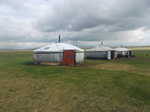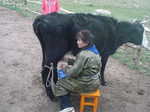Home » Adventures » Mongolia
As another stop on my way from New Zealand to Europe, I visited Mongolia. I did not know what to expect there as I mainly visited since it is a popular stop off for tourists taking the train from Beijing to Moscow. I did not plan anything in advance but still got to go on a couple trips. Rather than reading about my time, you can also just look at all pictures from Mongolia.

I originally had a week planned in Mongolia and found a three day tour with several other people at my hostel. Due to its short length we did not venture too far from Ulaanbaatar but still got into the country side. We first visited Gorkhi Terelj National Park. I did not know specifically what made this area worthy of being a national park, or even what a national park designation in Mongolia meant, but it contained some interesting rock formations and hills. Being so close to Ulaanbaatar, this park was very popular, with many tourist camps. We did not stay in a big commercial camp, but with a family. They were setup though almost like a B&B, with the family cooking us meals and a separate ger for us. Our ger (a round house, similar to yurts) seemed fairly standard and traditional, although decorated with fancier coverings for the walls and ceilings than normally used. Food in Mongolia revolves around meat, and we ate mutton and rice. They also hand milked their own cows, with the milk being another integral part of their diet. They have devised many uses for it, including yogurt and tea.
The next day we traveled to the countryside, an area with wide open plains, which is much of Mongolia’s terrain. The people live out here and work hard raising sheep and goats.

We also visited the new large, gaudy Genghis Khan Statue. This monstrosity was basically purpose built to attract tourists and felt very out of place in Mongolia. It was a forty meters high, shiny metal statue of Genghis Kahn on a horse. You could climb inside and lookout from atop the horse’s head. There was a museum underneath, and a large area surrounding the complex that had big plans for the future. The place was not that old, but some parts of the museum were already cracking and falling apart.
We then went on a horse ride to a complex of Buddhist Temples, some of which were destroyed by Communists in the 1930s. I expected a slightly more rural location to start from, but we got atop the horses in the middle of town and rode them out. Horse riding is very popular in Mongolia, and they thought nothing of throwing me straight onto a horse, even though I told them I had not really ridden at all before. The horses were fairly tame though, and pretty much knew what to do and where to go on their own. But they just did not walk either, but accelerated to trotting and even some slow running. I held on tight for the bumpy ride and tried to keep my knees and bottom from getting too sore.
Overall the tour from the hostel was good. It was not very long, so we could not see or do too much, but it at least gave a taste of Mongolia. We did not interact with the families we stayed with as much as I expected though. True, they did not speak English, but they basically just brought us meals and did their own thing. There was also quite a bit of down time, even on this short excursion. This made it more relaxed, but I also had to find my own things to do sometimes.
While waiting for my flight to Germany, an opportunity arose for a much longer trip around Mongolia. A person staying in my dorm room was putting together a ten to twelve day trip. Most of the research had already been done, and all I had to do was basically pay my way, which was a reasonable cost since the trip was being run independently. Since I could also change my plane ticket without a fee I decided to go along.

As I would discover though, the amount of planning and organization was a little less than originally implied. Places to visit had been mostly agreed upon, but the nuts and bolts and execution left a lot to be desired. No one was in charge during the trip and there was no set itinerary, so we wasted a lot of time each doing work that could have been shared or better coordinated. Our group was divided into two jeeps, and communication between them was often lacking. We spent most of our time inside unable to talk to the other one. The people in the other jeep also all spoke the same language, so even when we were together when the jeeps stopped, they would talk amongst each other in a foreign tongue. That made it hard to strike up a conversation with them since I had no idea what they were talking about, and they would all have to switch to English for me to join.
The trip consisted mainly of endless, monotonous driving. That is part of the Mongolian experience, since the country is so big with little infrastructure. There were very few roads, and even less that were paved. We mainly followed bumpy, jeep tracks that were in poor condition. It got old though when we spent the entire day in the jeep driving to our next destination.

Our drivers were decent, considering there was not a single road sign in rural Mongolia. There were though, countless small intersecting jeep tracks in the expansive countryside. Their ability to mostly know the right way to go without a GPS or even a map was pretty amazing. They did not always pick the most direct route the first time but still eventually got there. They had to ask locals for directions on occasion, but that is unavoidable in such an undeveloped land.
Rural Mongolia was mostly a large, flat, endless expanse with few plants and almost no trees. There were occasional gers and herds of animals, but not much else. Even the groups of camels, which were raised for their meat, because routine and uninteresting after the hundredth one. Sitting in the jeeps for hours and days on end crossing the nothingness grew very tiresome after a few days.
We did see some interesting places, although we usually hurried through them even after the long drive there. Yolyn Am was a deep gorge in Gobi Gurvansaikhan National Park that has ice in its bottom nearly year round. Much ice accumulates during the winter, and without much direct sunlight and mild summers it lasts long into the year. Hiking through the bottom of the canyon was fun, as well as climbing over the remnants of the ice. The canyon itself was impressive too, with high, twisty rock walls along its length.
We also got to the sand dunes at Khongoryn Els. These were basically a single long, tall sand dune, with varied terrain on each side. The side we approached from had marshes and grasslands, while the other side had much lower sand dunes with occasional vegetation, before the landscape returned to arid dirt and rocks after a few kilometers. It seemed odd that such a relatively small ecosystem of sand would existed in a massive countryside of mostly mountains and flat plains of dirt, rocks, and shrubs. We climbed several hundred meters to the top of the sand dunes, which was not too bad of a climb until the last twenty-five vertical meters, where the sand became very steep and loose. The view though was amazing, as you could see the length of the sand dunes and surrounding country side. Climbing up the sand dunes was a lot of work, but also a lot of fun.
We also took a camel ride nearby, even though camels are ugly, smelly creatures. I got jostled around on its back some, but the ride was generally smooth. We could not really steer the camels, as they merely followed our guide, although we did occasionally have to provide additional coaxing to keep them walking. We rode a small loop at the base of the sand dunes, but it was a lot of fun. The bouncing, bumping, and odd creatures kept a smile on our faces.
Khermen Tsav, the “Grand Canyon of Mongolia” was also on our itinerary. It was indeed a large, long canyon. At the top end of the canyon we walked around the bottom of the canyon some. This was enjoyable but did not reveal anything spectacular. The canyon became more impressive though as we continued along its rim. It grew wider, deeper, and much more picturesque. We enjoyed the views, but all too quickly we were on our way for more endless driving.
There are many hot springs in Mongolia, and we stopped at one whose name I did not record. These were not large pools to soak in, but hot water trickled naturally from a variety of different rocks making interesting formations. The area was used for medicinal purposes by Mongolians, with each spring supposedly helping aid a different ailment or part of the body. The water was either drank or applied to the appropriate part of the body.
The Buddhist temples of Erdene Zuu were the last stop of our excursion. This was a large complex of temples and the remaining buildings that the Soviets had not destroyed had elaborate architecture and design. But for me, one temple looks quite like another after a while, and the large Buddha statues and Buddhist religious symbols were not interesting to me and carried no special meaning.